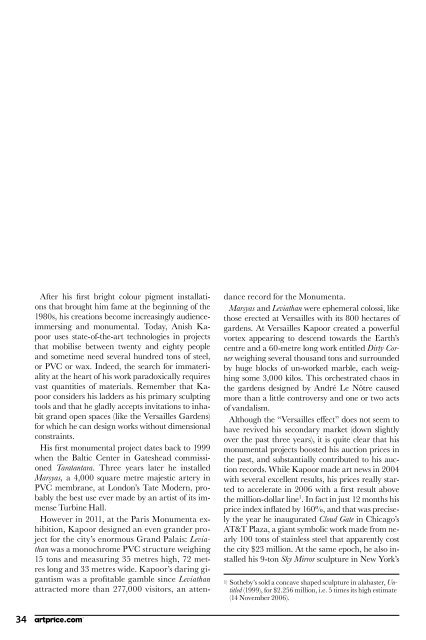THE contemporary
rCstpm
rCstpm
Create successful ePaper yourself
Turn your PDF publications into a flip-book with our unique Google optimized e-Paper software.
After his first bright colour pigment installations<br />
that brought him fame at the beginning of the<br />
1980s, his creations become increasingly audienceimmersing<br />
and monumental. Today, Anish Kapoor<br />
uses state-of-the-art technologies in projects<br />
that mobilise between twenty and eighty people<br />
and sometime need several hundred tons of steel,<br />
or PVC or wax. Indeed, the search for immateriality<br />
at the heart of his work paradoxically requires<br />
vast quantities of materials. Remember that Kapoor<br />
considers his ladders as his primary sculpting<br />
tools and that he gladly accepts invitations to inhabit<br />
grand open spaces (like the Versailles Gardens)<br />
for which he can design works without dimensional<br />
constraints.<br />
His first monumental project dates back to 1999<br />
when the Baltic Center in Gateshead commissioned<br />
Taratantara. Three years later he installed<br />
Marsyas, a 4,000 square metre majestic artery in<br />
PVC membrane, at London’s Tate Modern, probably<br />
the best use ever made by an artist of its immense<br />
Turbine Hall.<br />
However in 2011, at the Paris Monumenta exhibition,<br />
Kapoor designed an even grander project<br />
for the city’s enormous Grand Palais: Leviathan<br />
was a monochrome PVC structure weighing<br />
15 tons and measuring 35 metres high, 72 metres<br />
long and 33 metres wide. Kapoor’s daring gigantism<br />
was a profitable gamble since Leviathan<br />
attracted more than 277,000 visitors, an attendance<br />
record for the Monumenta.<br />
Marsyas and Leviathan were ephemeral colossi, like<br />
those erected at Versailles with its 800 hectares of<br />
gardens. At Versailles Kapoor created a powerful<br />
vortex appearing to descend towards the Earth’s<br />
centre and a 60-metre long work entitled Dirty Corner<br />
weighing several thousand tons and surrounded<br />
by huge blocks of un-worked marble, each weighing<br />
some 3,000 kilos. This orchestrated chaos in<br />
the gardens designed by André Le Nôtre caused<br />
more than a little controversy and one or two acts<br />
of vandalism.<br />
Although the “Versailles effect” does not seem to<br />
have revived his secondary market (down slightly<br />
over the past three years), it is quite clear that his<br />
monumental projects boosted his auction prices in<br />
the past, and substantially contributed to his auction<br />
records. While Kapoor made art news in 2004<br />
with several excellent results, his prices really started<br />
to accelerate in 2006 with a first result above<br />
the million-dollar line 1 . In fact in just 12 months his<br />
price index inflated by 160%, and that was precisely<br />
the year he inaugurated Cloud Gate in Chicago’s<br />
AT&T Plaza, a giant symbolic work made from nearly<br />
100 tons of stainless steel that apparently cost<br />
the city $23 million. At the same epoch, he also installed<br />
his 9-ton Sky Mirror sculpture in New York’s<br />
1) Sotheby’s sold a concave shaped sculpture in alabaster, Untitled<br />
(1999), for $2.256 million, i.e. 5 times its high estimate<br />
(14 November 2006).<br />
34


